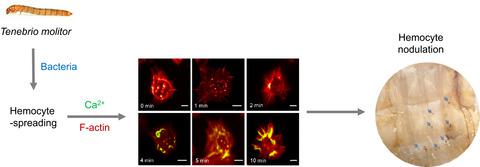当前位置:
X-MOL 学术
›
Entomol. Exp. Appl.
›
论文详情
Our official English website, www.x-mol.net, welcomes your
feedback! (Note: you will need to create a separate account there.)
Eicosanoid-induced calcium signaling mediates cellular immune responses of Tenebrio molitor
Entomologia Experimentalis et Applicata ( IF 1.4 ) Pub Date : 2021-02-16 , DOI: 10.1111/eea.13037 Miltan Chandra Roy 1 , Yonggyun Kim 1
Entomologia Experimentalis et Applicata ( IF 1.4 ) Pub Date : 2021-02-16 , DOI: 10.1111/eea.13037 Miltan Chandra Roy 1 , Yonggyun Kim 1
Affiliation

|
Calcium signaling is associated with actin cytoskeleton rearrangement. It is required for expressing cellular immune responses of insect hemocytes. Eicosanoids mediate immune responses by cytoskeleton rearrangement against various pathogen infections in insects. The objective of this study was to investigate cellular immune responses of a mealworm, Tenebrio molitor L. (Coleoptera: Tenebrionidae). The hypothesis tested was that immune responses would be mediated by calcium signaling associated with eicosanoid mediation. Larvae of T. molitor possessed at least four morphological types of hemocytes, most (almost 75%) of which were granulocytes and plasmatocytes. They all exhibited a hemocyte-spreading behavior by F-actin extension. Upon bacterial infection, hemocytes exhibited phagocytosis and formed hemocytic nodules. Intracellular calcium was detected in hemocytes. Its amount increased with increasing incubation time after bacterial infection. Inhibition of calcium influx or release from endoplasmic reticulum using specific inhibitors prevented cellular immune responses. Interestingly, treatment with an eicosanoid biosynthesis inhibitor suppressed calcium signals induced by bacterial challenge. Furthermore, treatment with naproxen, a prostaglandin (PG) synthesis inhibitor, or esculetin, a leukotriene synthesis inhibitor, also inhibited the increase of calcium concentration in hemocytes. Among eicosanoids, PGE2 highly stimulated the increase of calcium signals. These results suggest that cellular immune responses of T. molitor are triggered by calcium signaling, which is up-regulated by eicosanoids.
中文翻译:

类二十烷酸诱导的钙信号介导黄粉虫的细胞免疫反应
钙信号与肌动蛋白细胞骨架重排有关。它是表达昆虫血细胞的细胞免疫反应所必需的。类二十烷酸通过细胞骨架重排介导针对昆虫中各种病原体感染的免疫反应。本研究的目的是调查粉虫黄粉虫(Tenebrio molitor L.)(鞘翅目:黄粉虫科)的细胞免疫反应。测试的假设是免疫反应将由与类花生酸介导相关的钙信号介导。幼虫黄粉虫具有至少四种形态类型的血细胞,其中大部分(近 75%)是粒细胞和浆细胞。它们都通过 F-肌动蛋白延伸表现出血细胞扩散行为。在细菌感染后,血细胞表现出吞噬作用并形成血细胞结节。在血细胞中检测到细胞内钙。其数量随着细菌感染后潜伏期的增加而增加。使用特定抑制剂抑制钙从内质网流入或释放可防止细胞免疫反应。有趣的是,用类花生酸生物合成抑制剂治疗抑制了细菌攻击诱导的钙信号。此外,用萘普生(一种前列腺素 (PG) 合成抑制剂)或七叶亭(一种白三烯合成抑制剂)进行治疗,还抑制血细胞中钙浓度的增加。在类二十烷酸中,PGE2高度刺激钙信号的增加。这些结果表明T. molitor 的细胞免疫反应是由钙信号触发的,钙信号被类二十烷酸上调。
更新日期:2021-02-16
中文翻译:

类二十烷酸诱导的钙信号介导黄粉虫的细胞免疫反应
钙信号与肌动蛋白细胞骨架重排有关。它是表达昆虫血细胞的细胞免疫反应所必需的。类二十烷酸通过细胞骨架重排介导针对昆虫中各种病原体感染的免疫反应。本研究的目的是调查粉虫黄粉虫(Tenebrio molitor L.)(鞘翅目:黄粉虫科)的细胞免疫反应。测试的假设是免疫反应将由与类花生酸介导相关的钙信号介导。幼虫黄粉虫具有至少四种形态类型的血细胞,其中大部分(近 75%)是粒细胞和浆细胞。它们都通过 F-肌动蛋白延伸表现出血细胞扩散行为。在细菌感染后,血细胞表现出吞噬作用并形成血细胞结节。在血细胞中检测到细胞内钙。其数量随着细菌感染后潜伏期的增加而增加。使用特定抑制剂抑制钙从内质网流入或释放可防止细胞免疫反应。有趣的是,用类花生酸生物合成抑制剂治疗抑制了细菌攻击诱导的钙信号。此外,用萘普生(一种前列腺素 (PG) 合成抑制剂)或七叶亭(一种白三烯合成抑制剂)进行治疗,还抑制血细胞中钙浓度的增加。在类二十烷酸中,PGE2高度刺激钙信号的增加。这些结果表明T. molitor 的细胞免疫反应是由钙信号触发的,钙信号被类二十烷酸上调。







































 京公网安备 11010802027423号
京公网安备 11010802027423号